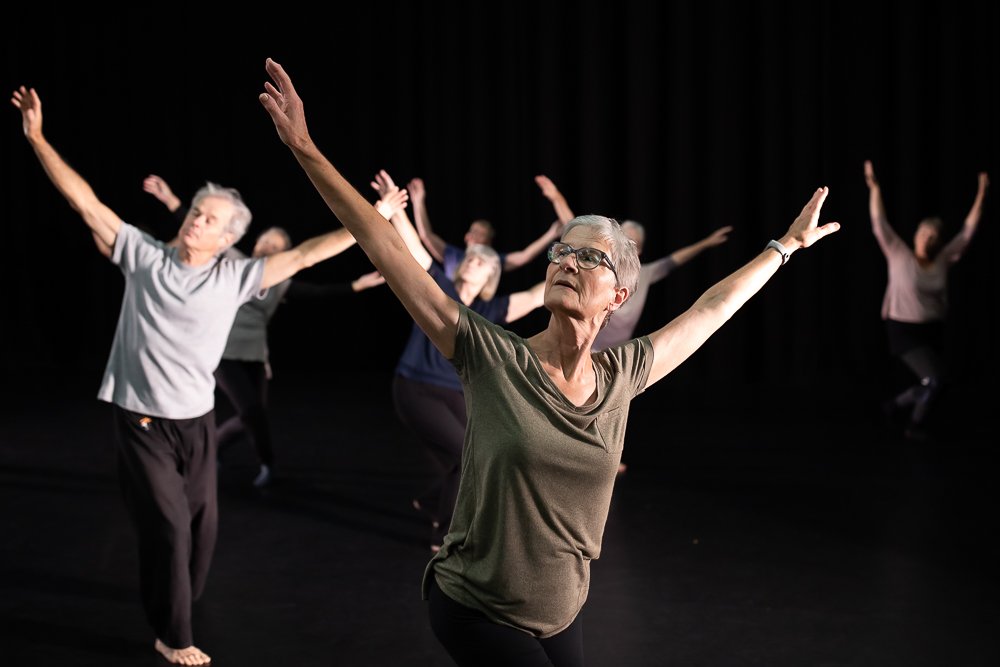
“As I watched yesterday, it struck me that the work we've done with RMDC has begun to increase our ability to 'take up our full space.’” EncoreEast dancer
Measuring range and quality of movement
Photos (c) Roswitha Cheshire
RMDC’s interest in adding a research perspective to what we do has stemmed not just from Dr Russell Maliphant’s ongoing curiosity and drive to understand and explore human movement and its aesthetic potential, but also from anecdotal comments about the difference people felt they could see in the quality of movement of his dancers, from when they started working with him to the point of performance.
This, combined with the idea that Russell’s practice could be health promoting and injury reducing while creating beautiful choreography – as it encourages each individual’s deeper somatic understanding of their movement – led us to ask ourselves whether the aesthetic outcomes seen and improvements felt could be objectively measured? However, this is no easy task and an area that is only just beginning to be explored in the dance science field. But given the interest from within the company and from our partners EncoreEast, in this first choreographic project since Covid lockdown, we thought, “why not see what we can see”. The company is interested in sharing best practice in taking healthy routes to improving dance performance at all ages and stages, and some measurable evidence would help us understand and articulate what works.
RMDC and EncoreEast with our research collaborator, Dance Scientist, Claire Farmer, decided to embrace a ‘mixed-methods’ approach and co-designed a quantitative strand to the research to be undertaken alongside EncoreEast dancer Stella Eldon’s qualitative ethnographic research. From a starting point of not wanting to interfere with the creative process or take away from the dancers’ enjoyment of moving, we chose some fairly straightforward, not too intrusive, measurements that will be analysed using Dartfish video analysis software. The aim being to explore range-of-motion and ‘flow’ or smoothness in the movements of the dancers. We are treating this as a pilot. In an ideal world we would have taken a first set of measurements at the beginning of the first stage of the project. We discussed if this might be possible using Zoom images but thought it was not ideal, so we compromised and met up at DanceEast at the beginning of stage two, just before rehearsals began in early September.
It was so good to meet all the dancers in person and hear how they were feeling about the upcoming first weekend creation period. Excited and apprehensive seemed to be the consensus! We chatted and enthused about what we’d already seen (see Reflections Blog) as each dancer arrived in turn and completed their own 3 minute warm up before their testing session. Between Russell, Edd and Claire, aided by EncoreEast’s Jeanette Siddall as our first experimental test participant, we had settled on the following simple tests, which it was felt reflected the key elements which would facilitate dancing RMDC’s style of choreography:
timed sit to stand test (lower body strength and movement strategies)
roll down (spinal range of motion)
arm raises (shoulder range of motion)
side bends and spinal twists (spinal range of motion in further planes)
These movements along with a short movement sequence inspired by the vocabulary used in Edd’s online classes, were videoed for analysis using Dartfish. The sequence included the range of motion (ROM) elements mentioned above along with changes in level, low to high, a turn, and shifting of weight from two to one foot, including balance elements. All movements will be videoed again in a post-rehearsal-period testing session and the pre and post results examined to see if there were any measurable changes in range of motion or the flow through linked movements, over time. Dancers and researchers alike are curious to see how these physical, objective measurements, may or may not reflect the experiences documented through the qualitative research, more on that in due course!


